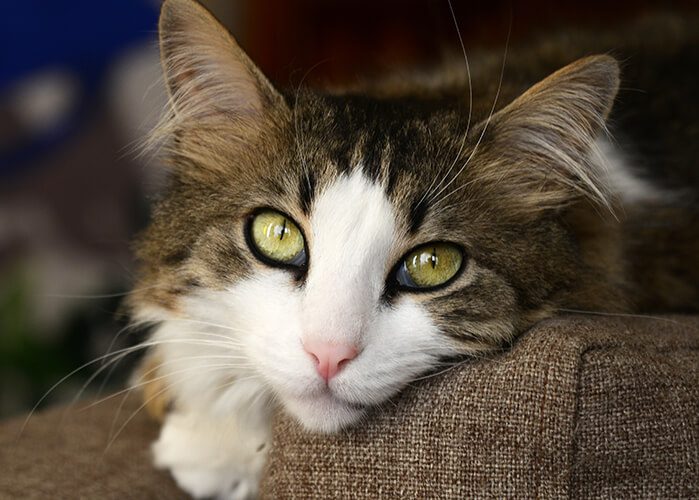Cat Diabetes in Limerick, PA: What it is and How to Help Your Pet
Diabetes can happen to pets of all ages but is more common in older pets. In cats, diabetes is common in animals that are 6 or older but it can happen in younger animals as well in some situations. Sometimes diabetes is the result of other health conditions, but it can occur on its own without other health issues spurring it on.
Diabetes occurs when the pancreas cannot make enough insulin and there is not enough energy for the cells to function correctly. This condition can lead to starved cells that cause the body to break down fat and muscle instead of properly metabolizing food and other sources of energy. Cats can get Type I and Type II diabetes just like humans, and the management of each level of the condition is different.

What is Cat Diabetes?
Cat diabetes happens when your cat cannot use glucose normally. Glucose is how the body powers cells in the body and the production of this substance is controlled directly by a hormone that is called insulin. The pancreas makes insulin for use in the body to fuel the cells and maintain blood sugar levels.
Sugars are processed in the intestines after they have been consumed and they are converted into simple sugars that help to fuel the body. When diabetes is present, this process does not work correctly. Your cat will have trouble with energy and digestion as well as organ function when they have diabetes.
What Are the Symptoms of Diabetes in Cats?
The symptoms of this condition are very consistent and hard to miss. Diabetes is rarely diagnosed incorrectly, and you can trust the diagnosis that you have been given by your veterinarian. Older pets can start to show these symptoms gradually over time, but younger pets will often show symptoms abruptly.
- Cloudy eyes—this is more common in dogs but can happen in cats
- Chronic skin infections and bladder infections
- Loss of appetite
- Weight loss
- Increased appetite
- Excessive drinking
In younger pets, excessive thirst and weight loss are the most common symptoms. You might also notice that your pet seems lethargic and that they are scratching at their skin all the time.
How to Help Your Pet?
When your cat is diagnosed with diabetes, you will need to make some adjustments to their lifestyle. Cats struggle less than dogs when diagnosed with diabetes because they are designed to eat a protein-heavy diet. This can make the process of stabilizing their blood sugar hard with traditional kibble feeds but very easy with raw foods
Thankfully, there are some ways to help make sure that your cat is able to enjoy a healthier and happier life once they have been diagnosed with diabetes. Many cats are able to enjoy a really happy and healthy life so long as they get the right management for their condition.
1. Change the Diet
You will need to change your cat’s diet to a high-protein and low-carb diet. This means that you might have to change from a kibble feed to one that is raw. This is easier than it used to be, and you can buy pre-made raw food for your cat’s needs these days through both online sellers and even locally. A raw diet can make all the difference in stabilizing your cat’s blood sugar and removing kibble from your cat’s diet might be easier than you think.
2. Exercise
Many diabetic cats can be overweight. This is usually part of how they became diabetic. You will want to try to make sure that your cat is exercising enough each day. This can be easy with some cats and hard with others. Some people put their cats into a harness and walk them and other people invite their cats to play with toys.
Getting your cat to lose some weight might even help them to stop being diabetic. You will be able to better manage your cat’s blood sugar if they are being active and if they lose some weight.
3. Insulin Injections
For pets with an advanced case of diabetes, insulin injections might be necessary. These injections might be needed more than once a day for some pets in advanced stages of the disease. The injections are easy to administer and can be given under the skin at home. If your pet is very fractious, you might have to learn to restrain them to give the injections safely.
This is not always necessary for the health of your pet, but you should be prepared to be asked to deliver insulin injections on your own at home if your pet is older or if diet does not manage their symptoms well. You will be surprised at how easy it is to administer medication in this way and soon you and your pet will get into a rhythm with the injections.
Diagnosing Diabetes in Cats
The symptoms that were discussed earlier are key signs of the disease, but your vet will also run some tests to confirm the diagnosis. A blood test can confirm the diagnosis, but your vet might also run a urine culture as well. These are the two most common tests that are performed to make sure that your suspicion is correct.
Once diabetes has been diagnosed, treatment protocols can be put in place. The sooner that your cat is diagnosed correctly, the sooner that you can help them to feel better.
Diabetes in Cats Can be Treated
It is important to remember that diabetes can be treated in cats with ease. Advanced cases are harder to manage, but there are still effective management protocols that can be put in place for your pet. Diabetes is a manageable condition, and you will find that helping your pet to lose weight and managing their diet can make a big difference in their health overall. Insulin injections might be needed but you should not be discouraged by this addition to the management protocol.
Diabetes is increasingly easy to manage in cats of all ages and you will be glad that you took your cat to the vet to get a correct diagnosis and a treatment protocol to improve their health. To book an appointment at Limerick Veterinary Hospital call (610) 489-2848 or use the online form!
